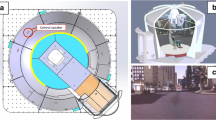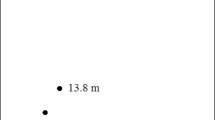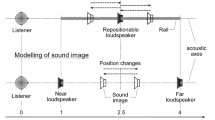Abstract
This paper describes which auditory information affects the accuracy of “perception of crossability” for blind people. We have created a “virtual 3D acoustic environment” in which subjects feel a car passing in front of them to help them cross a road safely. The system is theoretically based on acoustic “time-to-contact” information, which is the most important concept in Ecological Psychology. Experimental results suggest that blind people tend to estimate the acoustic “time-to-contact” significantly longer than did sighted people. However, there are no significant differences between their sensitivities toward the speed of a moving sound source and the gain level of indirect sounds.
Preview
Unable to display preview. Download preview PDF.
Similar content being viewed by others
References
Ashmead, D.H., Davis, D.L., Northington, A.: Contribution of Listeners’ Approaching Motion to Auditory Distance Perception. Journal of Experimental Psychology: Human Perception and Performance 21(2), 239–256 (1995)
Brunswik, E.: Perception and the representative design of psychological experiments. University of California Press, Berkeley (1956)
Cooksey, R.W.: JUDGMENT ANALYSIS -Theory, Methods, and Applications. Academic Press, Inc., London (1996)
Gibson, J.J.: The ecological approach to visual perception. Lawrence Erlbaum Associates, Inc., Hillsdale (1986)
Ito, K.: Auditory interceptive timing and familiarity with acoustic environment. Studies in Perception and Action IV, 83–87 (1997)
Ito, K.: Detection of occluding edges by the use of echolocation. Studies in Perception and Action V, 52-56 (1999)
Lee, D.N.: A theory of visual control of braking based on information about time-to-collision. Perception 5, 437–459 (1976)
Mershon, D.H., Bowers, J.N.: Absolute and relative cues for the auditory perception of egocentric distance. Perception 8, 311–322 (1979)
Rosenblum, L.D., Carello, C., Pastore, C.R.: Relative effectiveness of three stimulus variables for locating a moving sound source. Perception 16, 175–186 (1987)
Schiff, W., Oldak, R.: Accuracy of judging time to arrival: Effects of modality, trajectory, and gender. Journal of Experimental Psychology: Human Perception and Performance 16, 303–316 (1990)
Shaw, B.K., McGowan, R.S., Turvey, M.T.: An Acoustic Variable Specifying Time-to-Contact. Ecological Psychology 3(3), 253–261 (1991)
Shiose, T., Sawaragi, T., Nakajima, A., Ishihara, H.: Design of Interactive Skill-Transfer Agent From a Viewpoint of Ecological Psychology. International Journal of Human-Computer Interaction 17(1), 69–86 (2004)
Shiose, T., Ito, K., Mamada, K.: The Development of Virtual 3D Acoustic Environment for Training Perception of Crossability. In: Miesenberger, K., Klaus, J., Zagler, W., Burger, D. (eds.) ICCHP 2004. LNCS, vol. 3118, pp. 476–483. Springer, Heidelberg (2004)
Shiose, T., Ito, K., Mamada, K.: Virtual 3D Acoustic Training System Focusing on Differences among Individual Clues of Crossing Roads. In: Proccdings of 2nd International Conference on Enactive Interfaces, Genova, Italy (November 2005)
Singleton, J.: Japanese Folkcraft Pottery Apprenticeship: Cultural Patterns of an Educational Institution in Coy ed. (1989)
Author information
Authors and Affiliations
Editor information
Editors and Affiliations
Rights and permissions
Copyright information
© 2006 Springer-Verlag Berlin Heidelberg
About this paper
Cite this paper
Shiose, T., Ito, K., Mamada, K. (2006). Identification of Acoustic Factors for Perception of Crossability Common to Blind and Sighted Pedestrians. In: Miesenberger, K., Klaus, J., Zagler, W.L., Karshmer, A.I. (eds) Computers Helping People with Special Needs. ICCHP 2006. Lecture Notes in Computer Science, vol 4061. Springer, Berlin, Heidelberg. https://doi.org/10.1007/11788713_183
Download citation
DOI: https://doi.org/10.1007/11788713_183
Publisher Name: Springer, Berlin, Heidelberg
Print ISBN: 978-3-540-36020-9
Online ISBN: 978-3-540-36021-6
eBook Packages: Computer ScienceComputer Science (R0)




